About the Wellcome Osteological Research Database
The Centre for Human Bioarchaeology holds a huge amount of data about the remains in its collection and the circumstances of their excavation. This information is publicly available.
Content
The osteological database contains descriptions of the human remains excavated from various cemetery sites in the London area, contained in:
- Period summaries describing the general nature of burials at various point in the city's history
- Cemetery summaries describing individual excavation sites
- Downloadable data and photographs describing individual skeletons from different cemetery sites, down to the context level.
The museum's collections also include prehistoric human remains, such as crania found in the river Thames, Roman cremations, and a number of Anglo-Saxon skeletons (inhumed and cremated). This material is being added to the database and our online content. Information about these sites can be found using the LAARC online catalogue.
Please note information may be updated or changed by the Centre in light of on-going research.
Registering your use of the database
We ask all users who download osteological data to complete the Database user registration form to help us improve this resource.
About the database
The Oracle Wellcome Osteological Research Database (WORD) database was designed to permit the rapid recording of human remains, and to allow data to be easily queried for research and curation purposes by the Museum of London.
The recording system follows the recommended professional standards:
- Buikstra, J.E. and Ubelaker, D.H. (eds.), 1994. Standards for data collection from human skeletal remains: proceedings of a seminar at the Field Museum of Natural History. Arkansas.
- Brickley, M. and McKinley, J. (eds.), 2004. Guidelines to the standards for recording human remains. BABAO and IFA Paper No. 7.
- Mays, S., Brickley, M. and Dodwell, N. 2002. Human bones from archaeologica sites. Guidelines for producing assessment documents and analytical reports. BABAO and English Heritage..
The Osteology Method Statement (revised 2012) (PDF 514kb), details the methods used to determine age, sex, stature and skeletal indices. It also describes how skeletal and dental pathology is classified, diagnosed and recorded.
The WORD database system has three main components used to record sub-adult and adult individuals:
- to capture basic contextual information for each skeleton
- to record all bones and teeth present
- to record:
In relation to the database and its use, coding and procedures for data entry have been standardised. The database manual (PDF 194kb, opens in a new tab) describes the coding used in the recording of skeletal data and is a necessary tool for understanding all data downloads.
Referencing the Oracle WORD database
In the text: WORD database, year - cite the year you downloaded the data.
For example, (WORD database, 2016).
In the bibliography: WORD database, Museum of London. Accessed (dd/mm/yy) and the webpage address
For example, WORD database, Museum of London. Accessed (01/08/16)
Additional pathological information
The additional pathological records are paper based records (PBR) also separated by cemetery. These supplement the pathological descriptions in the data downloads, and were only written if documentation space on the database was exceeded. If an individual context number does have these records, it will be stated in the data download.








